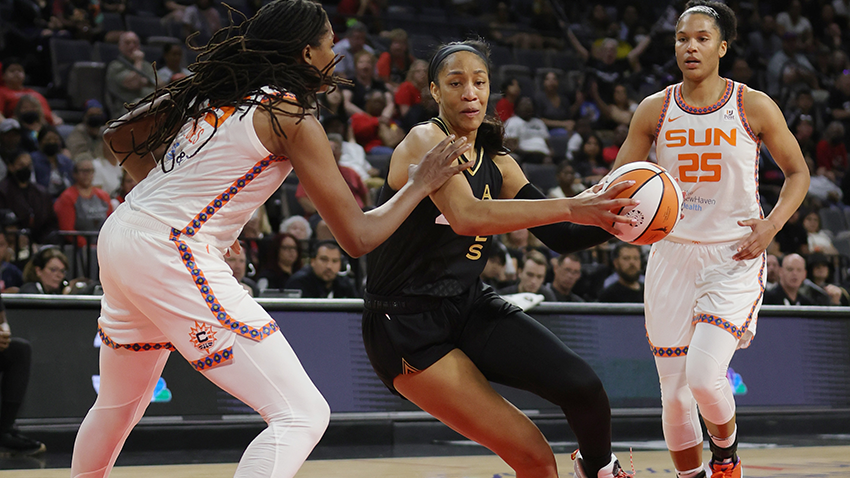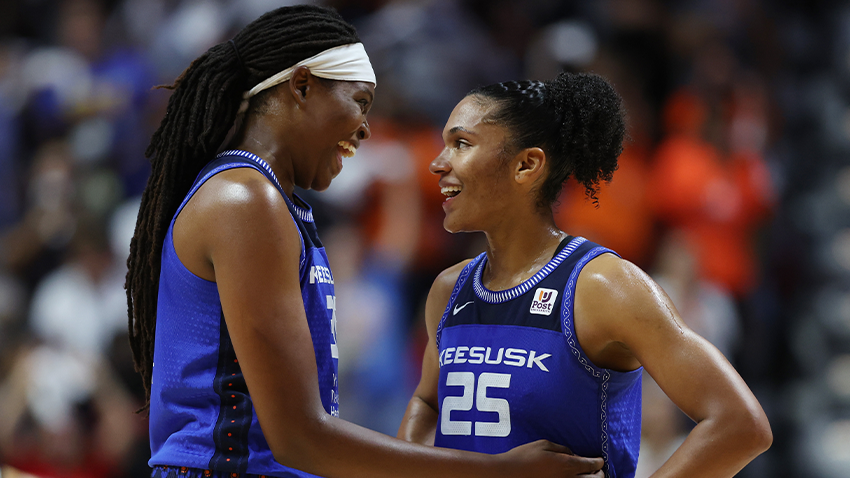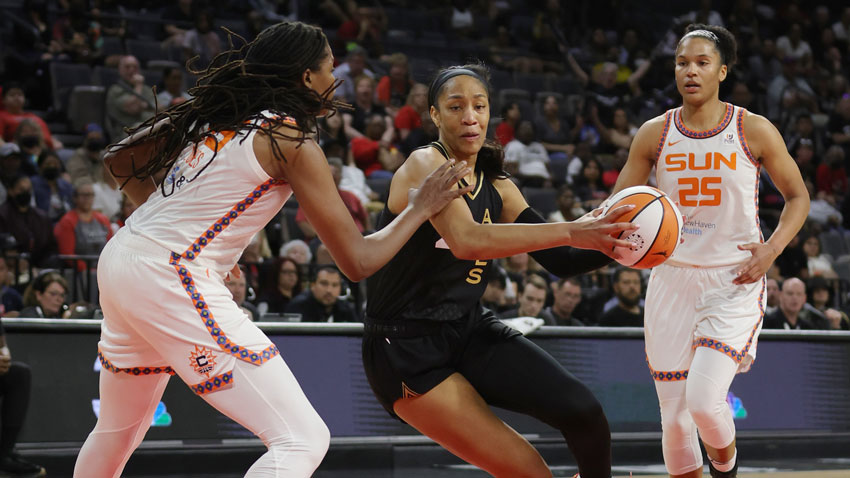WNBA Finals 2022: Lessons Learned from Game 1

Once the Connecticut Sun made their historic comeback against the Chicago Sky to win Game 5 of the Semi-Finals and advance to meet the Las Vegas Aces in the WNBA Finals, it was time to start breaking down the championship matchup.
In previewing the impending series, we looked at key questions, individual matchups, statistics, and previous meetings to guide our projections of how the Finals may play out. But, of course, all of this analysis is just on paper. How would the actual games compare to what we thought might happen?
We got our first impression on Sunday as the Aces edged out the Sun, 67-64, to take Game 1 of the 2022 WNBA Finals presented by YouTube TV in front of a sellout crowd at Michelob Ultra Arena in Las Vegas. Here are five key lessons learned from Sunday’s action.
1. Connecticut imposed their style of play on Las Vegas … but Las Vegas still got the win
This series presents a clear strength vs. strength matchup: Las Vegas’ high-powered offense against Connecticut’s stingy defense. The Aces not only led the WNBA in offensive efficiency this year but also posted the second-best offensive rating in league history. When the Aces are at their best, their offense performs like a world-class symphony. The task for the Sun was to turn that offense into a low-budget cover band.
And for most of the game, the Sun did just that. After the Aces got off to a hot start to open the game — leading 21-9 and shooting 8-11 (72.7%) from the field in the game’s first six minutes — the Sun defense took over. From that point on, the Sun outscored the Aces 29-13 for the rest of the first half as the Sun imposed their physicality on both ends of the court.
The Aces entered the Finals averaging 92.3 points per game in the playoffs, compared to just 79.8 points per game for the Sun. Connecticut’s best chance to succeed is to keep the score in the 60s and 70s, keep the shooting percentages low and force as many turnovers as possible to limit Las Vegas’s offense.
Connecticut coach Curt Miller calls this a “messy” style of play, and it almost worked in Game 1.
“Really pleased with holding that high-powered offense down and got the style of play we wanted,” Miller said after the game. “So, we are encouraged, but I’m disappointed that it didn’t equate to a win.”
“After this game, we have to have a lot of confidence,” added Alyssa Thomas. “I mean, this is a three-point game, and we had a chance to tie.
“I think we are very confident, and we know that all you need is one, and then there are two games at our place. So yeah, there are some things we can clean up. Of course, we can make more shots, but overall we played a hard game.”
On the other side, Las Vegas proved it could still win while being forced to play Connecticut’s game. The Aces don’t want a repeat of this type of game, but they showed on Sunday that they could win ugly as well as win pretty.
2. Chelsea Gray’s hot streak did not cool off with five days off from the Semi-Finals to the Finals
A key factor in the Aces pulling out a win while playing a game more suited for Connecticut’s style is the fact that they have Chelsea Gray to hit tough shots against great defense and keep the Aces scoring when their offense sputters.
Entering the Finals, Gray averaged 24 points per game while shooting 62.6% from the field and 59.5% from beyond the arc. While she didn’t quite reach those marks in Game 1 — she finished with 21 points on 9-17 (52.9%) shooting from the field and 2-7 (28.6%) from three – she was able to make timely baskets despite whatever defense the Sun threw her way.
“Nothing came easy for Chelsea,” said Miller. “Nearly every single shot, again, was
contested or made difficult. So, you’ve got to be pleased with that.
“She just is a tough shot maker, but as long as they are contested, we will be pleased that for 40 minutes if you continue to try to make them as difficult as possible. We gave her different looks. A lot of different people guarded her. We tried to keep her off-balance.”
Throughout the game, multiple Sun defenders took their shot at guarding Gray, whether it be guards like Natisha Hiedeman or Courtney Williams or some of Connecticut’s longer forwards like DeWanna Bonner and Thomas.
“My fade away, I’m able to get it off, off of long defenders,” said Gray. “They have Alyssa Thomas and Bonner, so how can I get my shot off and be efficient with it and just get to my spots and use my legs?”
3. Connecticut dominated the paint, offensive glass, and fast-break points for much of the game
We knew entering the series that Connecticut and Las Vegas were on near polar ends when it came to points in the paint (Sun 44.5 ppg, Aces 32.0) and points off 3-pointers (Aces 33.0 ppg, Sun 12.9 ppg).
However, in Game 1, the disparity in the paint was even greater than expected as the Sun doubled up the Aces 40-20 inside. Alyssa Thomas nearly matched the entire Aces roster in points in the paint as she finished with 18. On the other hand, the Aces did not win the battle of the 3-point line as both teams finished with five 3-pointers made, with the Aces shooting just 20.8% — their second-lowest percentage in any game this season.
Another area that the Sun dominated on paper and in Game 1 was the offensive glass, as Connecticut finished with a 13-6 advantage. The Sun had seven offensive rebounds in the second quarter alone when they outscored the Aces 21-9 to take a four-point lead into halftime. It also led to a heated halftime message from Hammon to her Aces players.
“I was lit,” said Hammon.” Because of everything we had talked about, we didn’t do any of it.
“They had beat us in every hustle category, and that can’t happen. You can’t lose a championship, game, or quarter on hustle. That can never be the case.
“Points in the paint, rebounding, hustle points, transition points, second-chance points. You can go down the list; we didn’t do any of them until the second half.”
4. The physicality – especially on the front lines – was key to which team held the momentum throughout the game
The game opened with the two most recent league MVPs – Connecticut’s Jonquel Jones and Las Vegas’ A’ja Wilson – defending one another. That was an advantage for Wilson in the early minutes as Jones’ length, and height did not phase Wilson on offense. Going back to that early 21-9 run in the first six minutes of the game, eight of those points came from Wilson going at Jones.
Then the Sun switched things up and put Thomas on Wilson, and while the 6-2 Thomas doesn’t have the same length as the 6-6 Jones, Thomas adds a level or physicality that few defenders in the WNBA can match. This time it was an advantage for Thomas as Wilson was less effective against her defense for the rest of the first half.
We alluded to Hammon’s halftime speech, and the Aces responded by upping their level of intensity and physicality in the second half. After being dominated 8-2 on the offensive boards in the first half, the Aces closed the gap to 5-4 in the second. Vegas doesn’t necessarily have to beat Connecticut in those categories, but they must keep them close.
“Rebounding is not about size. Size certainly helps, but that’s not the final story,” said Hammon. “They are relentless on the glass. We feel if we can just keep it close, we’ll be doing well because that’s what they do best.”
5. Dearica Hamby was able to give the Aces 11 critical minutes in the second half after playing just eight total leading into the Finals
Hamby’s availability and expectations for her production were question marks when previewing this series. After sustaining a bone bruise in her knee late in the regular season, Hamby missed the first four games of the playoffs before returning in Games 3 and 4 of the Semi-Finals but played a total of just eight minutes.
Hamby did not play in the first half, but with Hammon needing a boost of energy and toughness, she turned to Hamby in the third quarter, and the two-time Sixth Woman of the Year delivered by making an immediate impact off the bench.
“Dearica didn’t get a sniff in the first half and comes out and completely changes the aspect of the game,” said Hammon. “That’s a pro, first of all, but being ready to go is a mentality. Her mentality is more of a physical mentality. That’s what we needed, so that’s what we told them.”
“She was huge for us,” added Gray on Hamby’s impact. “Came in, energy plays. It’s not going to show in the stat sheet. I was just like, yeah, D! She was making all the right plays when it was a rebound, getting deflections, getting a 24 violation when she was out there. Just the little things, she sparked it for us, and that is where it was a turning point, and we took control of the game. It was all energy, heart, and effort. That’s hard to do. She was cold, too. She didn’t have a warmup when she came into the game. She came in right away and was effective.”
“Energy,” Miller said when asked of Hamby’s impact on Game 1. “I thought her two offensive rebounds were important to them in that stretch. She got them extra possessions which led to baskets. I might be mistaken, but she might have the best plus/minus on the team tonight for them.”
Miller was correct as Hamby finished tied with Gray and Wilson with a team-best plus-seven in plus/minus.
Longtime WNBA reporter Brian Martin writes articles on WNBA.com throughout the season. The views on this page do not necessarily reflect the views of the WNBA or its clubs.









,xPosition=.5,yPosition=.5)
,xPosition=.5,yPosition=.5)
,xPosition=.5,yPosition=.5)
,xPosition=.5,yPosition=.5)